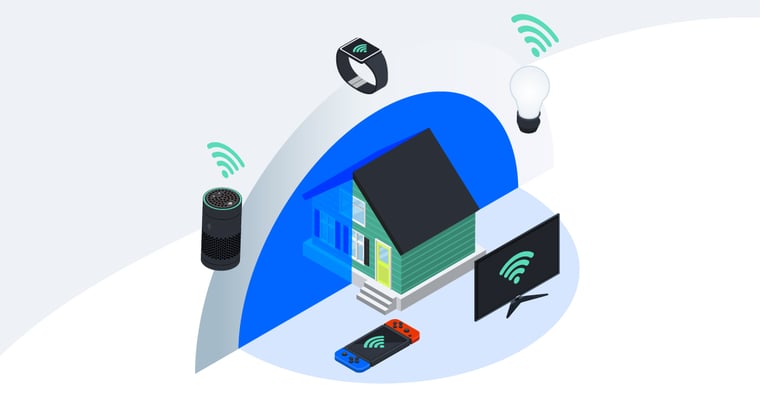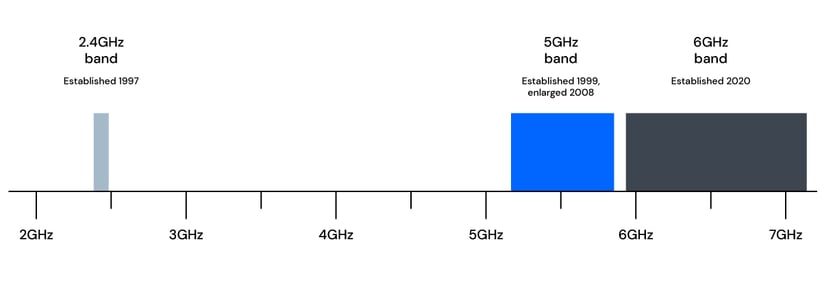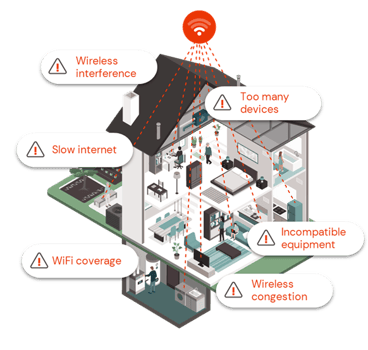2.4 vs 5GHz: The science behind connectivity issues in IoT devices

WiFi has come a long way since its birth 26 years ago. Initially, it supported a paltry 2Mbps at 2.4GHz. Technology evolves and today, there are an estimated 18 billion WiFi-enabled devices in use and over 4 billion new devices shipping annually.
New features and frequency bands have been added, the latest being the 6GHz band which supports a maximum link speed of 9.6Gbps. That’s 48,000 times the original speed in 1997.
WiFi frequency bands

The faster the better, right? Yet 2.4GHz remains the most popular band today, and the majority of smart home products only support 2.4GHz. To understand why, let’s explore the science behind the bands. Since 6GHz products are still in the initial stages of commercial availability, we’ll focus on comparing 2.4 vs 5GHz.
2.4 vs 5GHz bands
Hands down, the 5GHz band carries much more wireless traffic. That’s apparent just by looking at the graphic above. Speed may be important for a security camera video feed, but range may be the deciding factor for a smart garage door opener located far from the router. The advantage of 2.4GHz is that it has longer range and better coverage.
Range and coverage
The reason is that lower wireless frequencies pass through walls and furniture better than higher ones. For example, a 2.4GHz signal drops by 70% when going through drywall, compared to 90% for 5GHz. For a brick wall, it’s a 63% drop at 2.4GHz and 83% at 5GHz. Lower frequencies also have longer wavelengths, which allows them to bend around objects easier. This means fewer WiFi dead spots and better coverage in the home.
Another advantage of 2.4GHz is that it is the original band. Backwards compatibility has been maintained through successive iterations of WiFi and due to its long history and ensuing economies of scale, 2.4GHz chipsets and modules are more cost-effective than 5GHz ones. If you’re the product manager of a smart home product, it’s often a no-brainer.
However, the 2.4GHz band is a crowded space, used not only by WiFi but also Bluetooth devices and microwave ovens. It often suffers from congestion and interference, resulting in connectivity issues for smart home products – which may lead to tech support challenges and poor brand perception.
Interference and congestion at 2.4GHz
A WiFi frequency band is divided into channels, similar to TV channels in the UHF/VHF band and radio stations in the AM/FM bands. In the US and Canada, WiFi channels 1-11 are widely used, 12-13 are restricted, and 14 is not used.
2.4GHz WiFi channels
Interference
An important point from the figure above is that 2.4GHz channels overlap each other. A network operating on channel 1 sends and receives data using some of the same frequencies as a network on channel 3. They will interfere with each other to some degree. Interference reduces wireless signal quality, which reduces the range, bandwidth, and performance of the network.
Worse yet, most routers will default to channels 1, 6, or 11 (colored blue in the figure above). This is because they do not overlap and hence do not interfere with each other. But in a large apartment building or condominium, you could easily be covered by ten or more WiFi networks. Remember, 2.4GHz has a longer range so a neighbor’s WiFi will more likely cover your home. Some of them will be using the channel as you, as there are only three non-overlapping channels to go around.
By comparison, the 5GHz band has 21 non-overlapping channels, so the chance of interference is much lower.
Congestion
When there’s a lot of data traffic on your channel and everything slows down, that’s called congestion. WiFi is a shared medium, meaning that when one device is talking, no one else can. The busier the channel, the harder it is to get a talking slot, which results in poor quality or stalled video, and even lost data.
On top of this, smart devices at a lower WiFi signal level or quality – such as those near the edge of network coverage or range – talk slower than devices close to the router and effectively uses more bandwidth. It’s possible that your home network can stream video to two devices located close to the router, but only to one device located at the edge of coverage.
Generally the more devices and traffic on your network, the greater the congestion. Smart products like lightbulbs and lawn sprinklers don’t use much bandwidth but can experience delays in turning on/off. Products that stream video will be most impacted, particularly when the whole family is at home and active.
Congestion is an intermittent issue that depends on total network usage, the placement of WiFi routers and repeaters/extenders, and can be a tricky problem to troubleshoot.
Band Steering
In an effort to relieve congestion at 2.4GHz, many routers and mesh WiFi systems today try to steer devices to connect on the 5GHz band instead. For 2.4GHz-only smart home products, this can be problematic. Band steering is not part of the WiFi standard so each manufacturer does it differently, which complicates troubleshooting. Many of the newer mesh systems present a merged network with a single network ID, which makes it impossible to split it into separate 2.4 and 5GHz networks.
Home WiFi is a dynamic environment
Connectivity issues for smart home products are often complex not just because of 2.4/5GHz band issues, but also because the WiFi environment changes constantly. New devices are added, old devices are replaced, and a video streaming subscription is upgraded to 4K. Traffic patterns change. That’s just in your own home – how about your neighbors, whose devices and usage can affect yours? Getting connected is one thing, staying connected is another.
How RouteThis helps smart products stay connected
The RouteThis platform leverages your customer’s smartphone to scan their home WiFi, providing your team with in-depth visibility and analysis. Our intelligent software then presents easy-to-follow troubleshooting steps for your support agents to guide the customer to a fast and effective resolution.
Alternatively, our self-service app guides the customer directly through the same troubleshooting steps. Our app functionality can be incorporated into your smart home app for a seamless brand experience, and the scan data is stored for analysis and deeper troubleshooting by level 2 tech support, if required. Book a demo with us to learn more.

